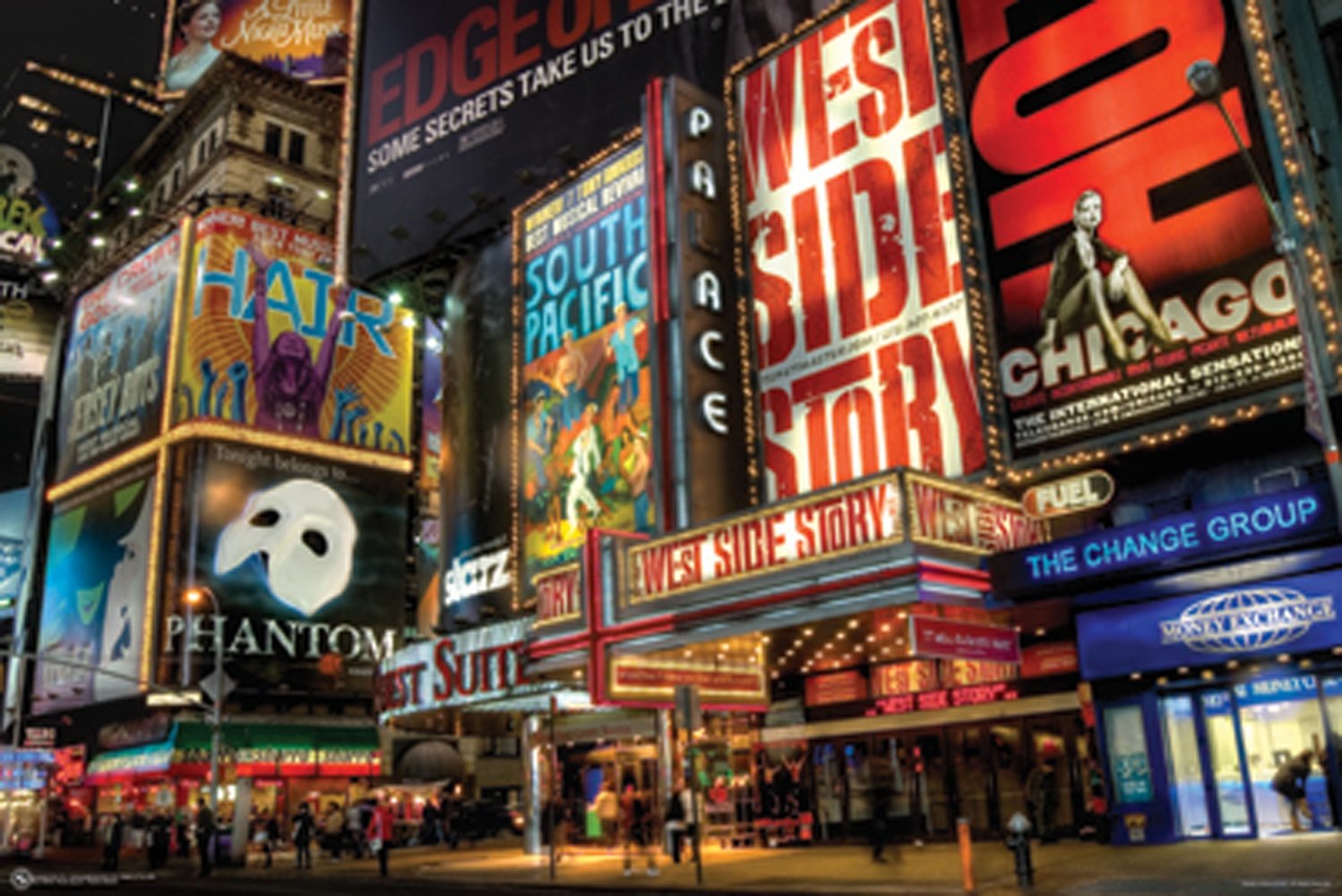Theater District, Manhattan - Times Square Theatre District
New York City's Theater District (sometimes spelled Theatre District, and officially zoned as the "Theater Subdistrict") is an area in Midtown Manhattan where most Broadway theaters are located, as well as many other theaters, movie theaters, restaurants, hotels, and other places of entertainment. It extends from West 40th Street to West 54th Street, and from Sixth Avenue to Eighth Avenue, and includes Times Square. The Great White Way is the name given to the section of Broadway which runs through the Theater District.
It also contains recording studios, record label offices, theatrical agencies, Music Row, ABC Television Studios, Duffy Square, Shubert Alley, the Brill Building, and Madame Tussauds of New York.

History
Origins and early history
The Theater District first began attracting theaters and restaurants to the neighborhood after the Metropolitan Opera House moved to West 39th Street and Broadway in 1883.
Over the years since then, the district has been referred to by New Yorkers as "the Rialto", as "The Main Stem", and as "Broadway", and at the turn of the 20th century, was simply called "The Street".
By the 1970s, the 42nd Street area in the district had become quite run-down and seedyâ€"with the opening of a number of X-rated movie houses, peep shows, and so-called grind houses operating thereâ€"and was even considered a rather dangerous place to venture into by most New Yorkers. The entire area was later greatly revitalized by the City in the 1990s, however, with the closing of most of those businesses, and with an array of new businesses being attracted in.
Joe Papp's "Save the Theatres" campaign
In the Spring of 1982, Joseph Papp, the Broadway theatrical producer and director who had established The Public Theater, led a campaign called "Save the Theatres" in Manhattan. The primary initial goal of the "Save the Theatres" effort, which was sponsored by Papp's not-for-profit group and supported by the Actors Equity union, was to save several theater buildings in the Theatre District neighborhood from their impending demolition by monied Manhattan development interests. Papp provided financial resources, campaign buttons, posters, and newspaper ads for the effort; recruited a publicist and celebrated actors to promote the cause; and provided various stage and street venues, audio, lighting, and technical crews for public events in support of the campaign for saving the historic theatres.
At Papp's behest, in July 1982, U.S. Congressman Donald J. Mitchell of New York, and 13 co-sponsors, introduced a bill in the 97th Congress (1981â€"82), entitled "H.R.6885, A bill to designate the Broadway/Times Square Theatre District in the City of New York as a national historic site". If enacted, it would have required the Federal Government to aid financially and otherwise in preserving the district and its historic theatre houses as an official National Historic Site. Faced with strong opposition and lobbying by the Mayor Ed Koch's Administration, however, the bill was never enacted, although it did help to publicize and call wide-spread attention to the effort.
The Save the Theatres campaign then turned their efforts toward supporting the establishment of the Theater District as a registered New York City historic district. In December 1983, Save the Theatres prepared "The Broadway Theater District, a Preservation Development and Management Plan", and demanded that each theater in the district receive landmark designation. Mayor Koch ultimately responded by creating a Theater Advisory Council, that included Papp as a member, and which eventually led to the area being officially zoned as the "Theater Subdistrict"
Theater Subdistrict zoning
In January 2001, the New York Appellate Division, First Department, upheld the validity of the 1998 Theater Subdistrict zoning regulations, which permit the sale of air rights from the Broadway theaters to sites in the Theater Subdistrict, "between 40th and 57th Streets and Sixth and Eighth Avenues". The New York City Department of City Planning press release stated: "The concentration of over 40 Broadway theaters makes the Theater District one of the most well-known areas in the world."
New York City also created the "Theater Subdistrict Council", LDC (“TSCâ€), a not-for-profit corporation, pursuant to the 1998 zoning regulation. Funds are deposited into the Theater Subdistrict Fund. The TSC administers the fund and allocates grants to promote new theater work and showcase Broadway's role in American theater.
The New York City Zoning Resolution for special purpose districts, as amended on April 30, 2012, contains special regulations for the Theater Subdistrict, including the transfer of development rights, incentives for the rehabilitation of existing theaters, the creation of a theater council to promote theaters, and zoning and signage for theaters, and contains a list of theaters that qualify for special provisions in the regulations.
New York Times Square Theater District Tour Vlog: Priscella, Chicago, Mama Mia
Boundaries
The City of New York defines the subdistrict for zoning purposes to extend from 40th Street to 57th Street and from Sixth Avenue to Eighth Avenue, with an additional area west of Eighth Avenue from 42nd Street to 45th Street. The Times Square Alliance, a Business Improvement District organization dedicated to improving the Theater District, defines the district as an irregularly shaped area within the bounding box of 40th Street, 6th Ave, 53rd Street, and 9th Ave.
Other nearby theater areas
The area known as Theatre Row is an area on 42nd Street from Ninth Avenue to Eleventh Avenue, which includes many Off-Broadway and Off-Off-Broadway theaters.

0 comments: